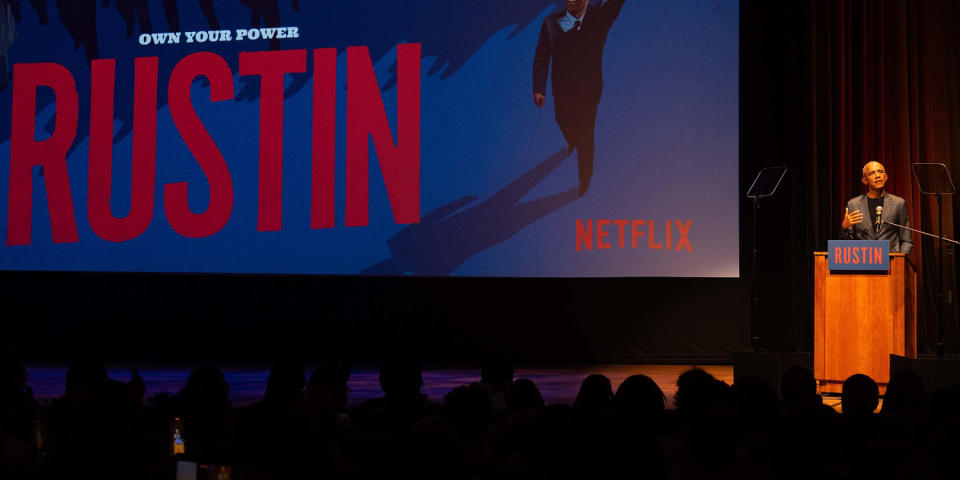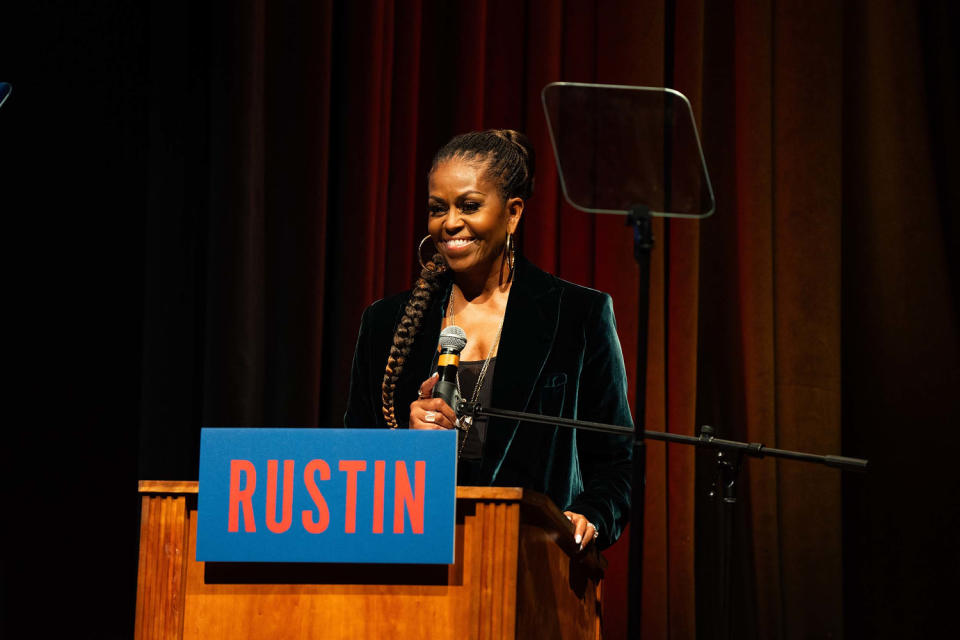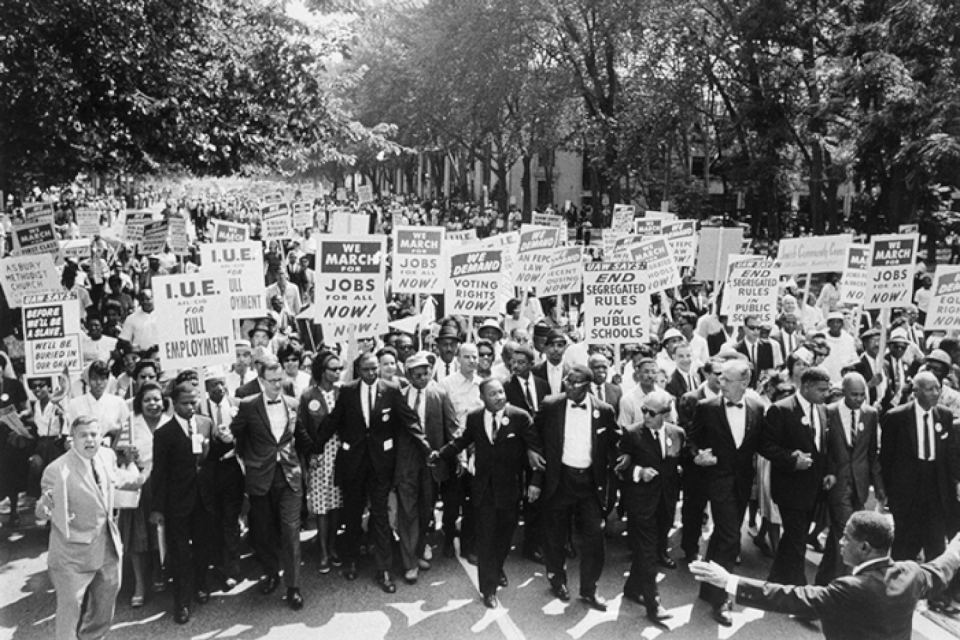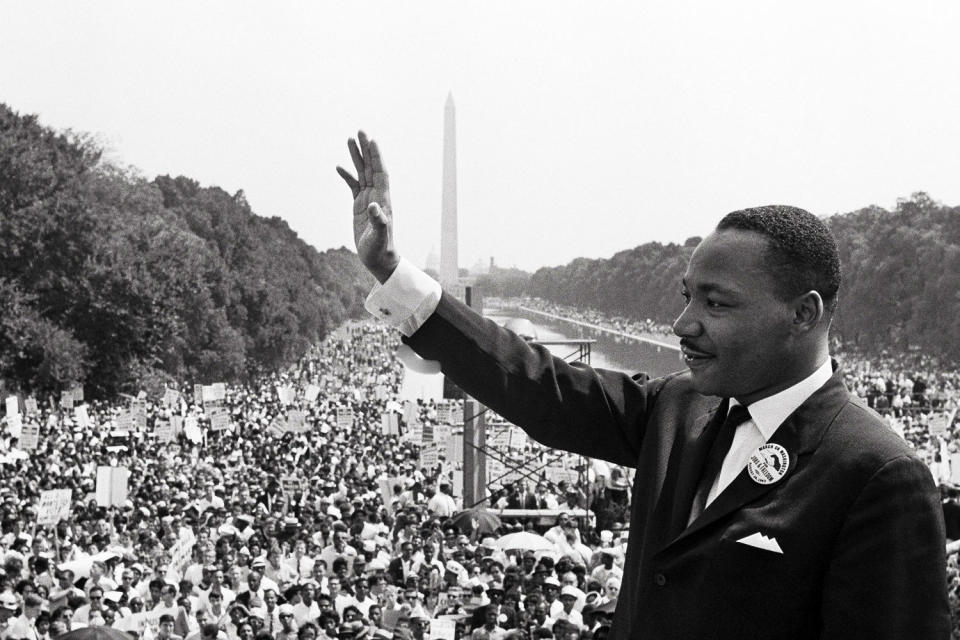Colman Domingo and the Obamas surprise audience at a 'Rustin' screening — see the pics
- Oops!Something went wrong.Please try again later.
- Oops!Something went wrong.Please try again later.
- Oops!Something went wrong.Please try again later.
President Barack Obama, Michelle Obama and "Rustin" star Colman Domingo made a surprise appearance at the opening night of the inaugural HBCU First Look Film Festival in Washington, D.C.
The former president and first lady were among other notable attendees who stayed for the Nov. 10 screening of "Rustin," a film about Bayard Rustin, the openly gay Black civil rights leader who was one of the driving forces behind the March on Washington.
The star-studded screening included the film’s director, George C. Wolfe, activist Joyce Ladner, the late Rustin’s partner, Walter Naegle, and Congresswoman Eleanor Holmes Norton. Wolfe and Domingo, who portrays Rustin in the film, also participated in a panel discussion about the upcoming film and its significance.

The Obamas offered their remarks on the film, with Michelle Obama sharing a special message to the "young people in the room."
"I know how easy it is to doubt who you are... to wonder if the way you look or where you’re from or who you love will leave you on the margins of the broader American story," she said. "But as you watch this movie, I want you to let Bayard Rustin’s example give you the strength to silence those doubts."
"Let his story remind you that no matter the complication, no matter the hardship, you can make history,” she continued.

Aug. 28 marked the 60th anniversary of the March on Washington for Jobs and Freedom, a day when around 250,000 people gathered in front of the Lincoln Memorial in Washington, D.C. to protest against the racial and economic inequalities of African Americans.
The event, which is simply referred to as the March on Washington, was also the day when Martin Luther King Jr. delivered his famous “I Have a Dream” speech. According to the National Archives, his speech, which resonated deeply with many Americans of that time, helped influence the federal government to “take more direct actions” toward racial equity.
On the anniversary, Netflix paid homage to the historical moment by releasing the first trailer for "Rustin." On Oct. 19, they released another promo, showing more of what went into organizing the historic day.
Directed by Tony Award-winning director Wolfe and starring Chris Rock, Glynn Turman and Jeffrey Wright, among others, the film hit select theaters on Nov. 3 before releasing on Netflix Nov. 17.
Here's what to know about the March on Washington and those who spearheaded the important event.
What led to the March on Washington?
The March on Washington was propelled by the lack of civil and economic rights for African Americans. In the 1940s, Black soldiers were excluded from World World II defense jobs and New Deal programs that were supposed to provide employment opportunities and relief to Americans, according to History.com.
While President Franklin D. Roosevelt agreed to issue an executive order forbidding discrimination against workers in defense industries and government, Congress didn't exactly see eye-to-eye with Roosevelt's plans.
In the mid '40s, Congress cut off funding for the Fair Employment Practice Committee that Roosevelt funded, which was supposed to ban discriminatory practices in the workplace.
In light of this, and many other disparities that Black Americans were facing during that time, labor leader A. Philip Randolph, NAACP executive secretary Roy Wilkins and his chief aide, Bayard Rustin, worked together to organize a mass march on Washington.
What happened at the March on Washington?
The March on Washington for Jobs and Freedom was 20 years in the making, according to the NAACP. It was a collective effort between the leaders of the six prominent civil rights groups who agreed that it would be better to combine two major causes into one mega-march on Washington.

The participating groups included various civil right leaders such as Randolph, the leader of the Brotherhood of Sleeping Car Porters; Wilkins, executive secretary of the NAACP; Dr. Martin Luther King Jr., chairman of the SCLC; James Farmer, founder of the Congress of Racial Equality (CORE); John Lewis, president of the Student Nonviolent Coordinating Committee (SNCC); and Whitney Young, executive director of the National Urban League.
Though President John F. Kennedy eventually supported the march, History.com reports that he had initially wanted the leaders to postpone the event, telling them that their march was “ill-timed.”
Still, the March on Washington proceeded as planned with Randolph kicking off the event with an inspiring speech.
“We here today are only the first wave," he said in part. "When we leave, it will be to carry the civil rights revolution home with us into every nook and cranny of the land, and we shall return again and again to Washington in ever-growing numbers until total freedom is ours."
Some of the other main speakers included Lewis, Arkansas NAACP President Daisy Bates, and Young with Rabbi Joachim Prinz and even dancer-actor Josephine Baker making smaller speeches.
Then, in what was supposed to be a four-minute speech to address economic and employment inequalities, Dr. King, who was the last speaker of the day, gave his riveting 16-minute "I Have a Dream" speech. King's heartfelt message, according to History.com, was historic, becoming the "most famous orations of the civil rights movement—and of human history."

"I have a dream that one day on the red hills of Georgia, the sons of former slaves and the sons of former slave owners will be able to sit down together at a table of brotherhood," he said.
“And when this happens…we will be able to speed up that day when all God’s children, Black men and white men, Jews and Gentiles, Protestants and Catholics, will be able to join hands and sing in the words of the old Negro spiritual, ‘Free at last! Free at last! Thank God Almighty, we are free at last!’”
What happened after the March on Washington?
The March on Washington helped to push through two major pieces of legislation. It's been credited with helping to pass the Civil Rights Act of 1964, which outlawed discrimination based on race, color, religion, sex or national origin.
It was also pivotal in getting President Lyndon B. Johnson to sign the National Voting Rights Act in 1965, which prohibited discriminatory voting practices and allowed Black Americans a clear path to the polls.
Together the two bills worked to legally end discriminatory practices in public places, employment and voting.
This article was originally published on TODAY.com

